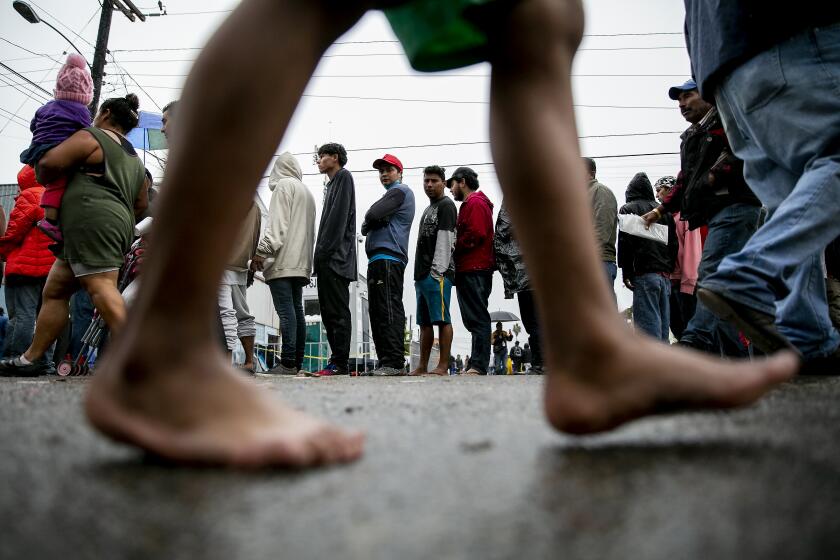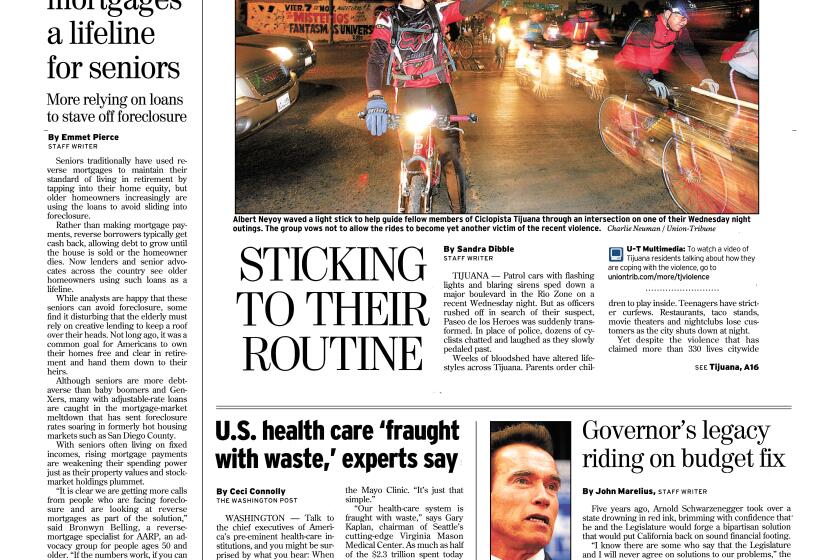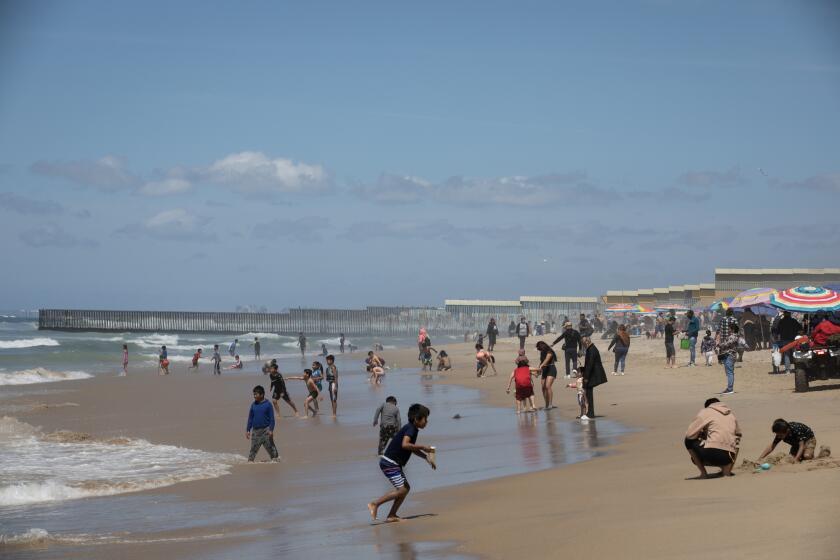Report: Feds must see border in new light
UCSD Extension collaborates with urbanist Richard Florida
The U.S. government has been single-mindedly focused on border security since the Sept. 11, 2001, terrorist attacks, preventing the San Diego-Tijuana region from reaching its full economic, social and cultural potential, according to a report released Thursday.
The report, co-authored by an internationally known urbanist who studies global competitiveness, calls for more efficient cross-border transportation infrastructure at ports of entry. It urges improved government systems and technologies that facilitate the crossings of people and goods across the border. It demands a reduced role for the U.S. Department of Homeland Security in border management, and greater participation by the departments of State and Commerce.
“Our national security concerns are real and urgent,” writes one of the report’s authors, Richard Florida, an urban studies professor who has written about mega-regions as drivers of global economic growth. “But we are not meeting them by tying up trucks in traffic, interrupting supply chains and torturing blameless business travelers and tourists with long lines and cumbersome bureaucracies.”
The report, a 25-page white paper, is entitled “From Border Barriers to Binational Promise: What the Future Could Be With a Frictionless Border.” While its findings might not come as a surprise to local residents and businesses well acquainted with wait times at U.S. ports of entry that can last several hours, the report’s authors are hoping to reach a broader audience — and capture the attention of federal policymakers — at a time when illegal immigration rather than trade has been dominating the national debate about the border.
Should the role of the Department of Homeland Security be reduced in policing the border?
Yes 43% (473)
No 57% (633)
1106 total votes.
The cost of the report was divided equally among 10 investors on both sides of the border, including Malin Burnham, the San Diego real estate investor and civic leader who has long championed stronger cross-border ties.
It was written jointly by the Creative Class Group, a New York consulting firm founded by Florida, and Global CONNECT, a consultancy based at UCSD Extention that specializes in entrepreneurship, innovation and technology commercialization.
“It’s a report that hopefully will get everybody’s attention,” Burnham said. “Leaders of Homeland Security ought to wake up and realize that there is a problem, and the best way to fix the problem is to have three-way management of this border.”
The report draws heavily upon existing data on the cross-border region, quoting research conducted through the San Diego Association of Governments, San Diego State University, the San Diego Regional Economic Development Corporation, the North American Research Partnership, the Brookings Institution in Washington, D.C., and the Martin Prosperity Institute at the University of Toronto, which is headed by Florida.
Among the numbers cited are figures from a 2007 SANDAG study that found inadequate infrastructure at ports of entry on the California-Mexico border cost the U.S. and Mexican economies $7.2 billion and 62,000 jobs. The Frictionless Border report also quotes from a Brookings Institution/J.P. Morgan Chase study showing that for every $100 in goods that the U.S. imports from Mexico, the products contain $40 in U.S. content.
The authors interview a range of local actors in the binational region, including scholars, entrepreneurs, maquiladora executives and members of the nonprofit sector.
“What is clear is that the U.S. agencies that are directly responsible for border security have failed to appreciate the economic and cultural/social opportunities that a binational region like San Diego/Tijuana presents,” the report states.
The report’s release comes at a key time, say its authors. The economies on both sides of the border have evolved significantly in recent years, creating new opportunities for the binational relationship.
“San Diego has transformed itself into an innovation hub, and Tijuana has transformed itself into of one of the most dynamic manufacturing hubs,” said Mary Walshock, dean of UCSD. “We need to be one economy.”
The long lines at the border are seen as the biggest impediment to integrating the economies, but obtaining federal funding for expansions and improvements has been a struggle. The busiest port of entry in the western hemisphere, San Ysidro, is in the midst of a major expansion that is expected to significantly relieve congestion, yet Congress not fully funded the $741 million project.
Rep. Juan Vargas, D-San Diego, said regional support for border improvements can make a difference in Washington, D.C. San Diego’s congressional delegation is now unified on the need to fund border infrastructure projects, helping bring more attention to the issue: “Minds are being changed as we speak,” Vargas said.
The Frictionless Border report can help make the case nationally. “It was spot on and took an international view and not a parochial San Diego view,” Vargas said. “We have to have investment that recognizes the dynamism of both sides.”
One of the main recommendations of the report: Give less power to the Department of Homeland Security, which was created after the Sept. 11 attacks. The department oversees U.S. Customs and Border Protection, the agency charged with patrolling the border as well as conducting inspections at the ports of entry.
The report states that “DHS is the only federal agency that has jurisdiction over both operations and policy in the security arena. This has led to security concerns overriding all other considerations in how U.S. borders are managed.”
The policy has led to economic and social costs, the report states. “It is time for economic and social development to be given equal weight.”
Disagreeing with such conclusions is Rudy M. Camacho, former director of field operations in San Diego for U.S. Customs and Border Protection, and currently a private consultant on customs and border management issues.
While DHS is the “front-line agency at U.S. ports of entry,” and charged with enforcing rules from some 40 U.S. agencies, Camacho said that it “does not work in a vacuum,” when setting policy. “You cannot set policy unilaterally,” he said. “Working cooperatively is how policies and operations are designed.”
But a former high-ranking member of the Obama administration, Michael Camuñez, agreed that “historically, there has been too much of an emphasis on security and not enough on trade facilitation and promoting economic and commercial ties,” between the United States and Mexico.
A former assistant U.S. secretary of commerce, Camuñez said bilateral efforts such as the 21st Century Border Management Initiative led to “a commitment to do joint planning on the U.S.-Mexico border” and expansion of initiatives such as CBP’s Trusted Traveler programs that give pre-approval to low-risk travelers entering the United States.
“That said, the fact is, more needs to be done,” said Camuñez, now president of ManattJones Global Strategies, a consulting firm that helps U.S. companies conduct business in Mexico. “We need the business community to make a more aggressive case on both sides of the border, not just in border infrastructure, but in other initiatives that will promote trade and investment with Mexico.”
Florida argues mega-regions are key to global economic growth, with 40 mega-regions around the world containing one-fifth of its population, but control two-thirds of the economic activity, including some that cross international borders such as Toronto-Buffalo-Rochester and Amsterdam-Brussels-Antwerp.
The report acknowledges that the border is not just a drawback but also offers advantages. “Even if a fully open border were politically feasible, it would have the effect of blurring complementarities that are generative of so much economic value,” the report states.
“We’re not border experts, but we’re economic experts,” said Steven Pedigo, director of research at the Creative Class Group, and one of the report’s main authors. “You’ve got a real opportunity here. Can you harness that?”
Get Essential San Diego, weekday mornings
Get top headlines from the Union-Tribune in your inbox weekday mornings, including top news, local, sports, business, entertainment and opinion.
You may occasionally receive promotional content from the San Diego Union-Tribune.











